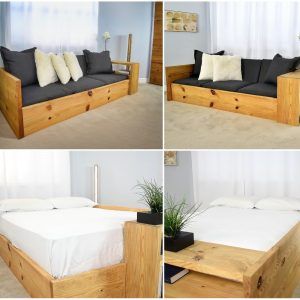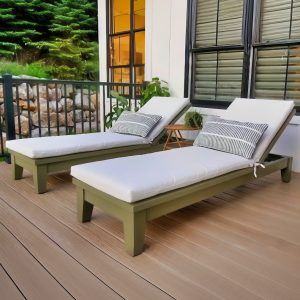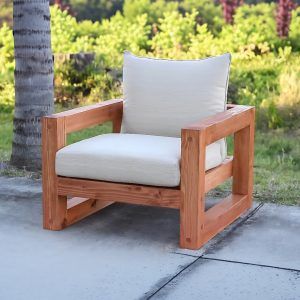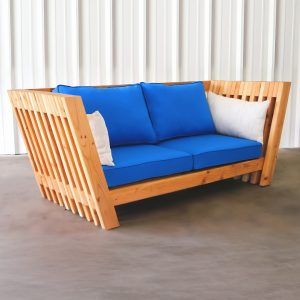Building an outdoor sofa can transform your garden or patio into a cozy retreat. Learn to make a durable, stylish DIY outdoor sofa, perfect for those sunny afternoons or cool evenings outside. This outdoor sofa project is ideal for DIY enthusiasts of all levels, and we’ve included expert tips and insights to make the process as smooth as possible.
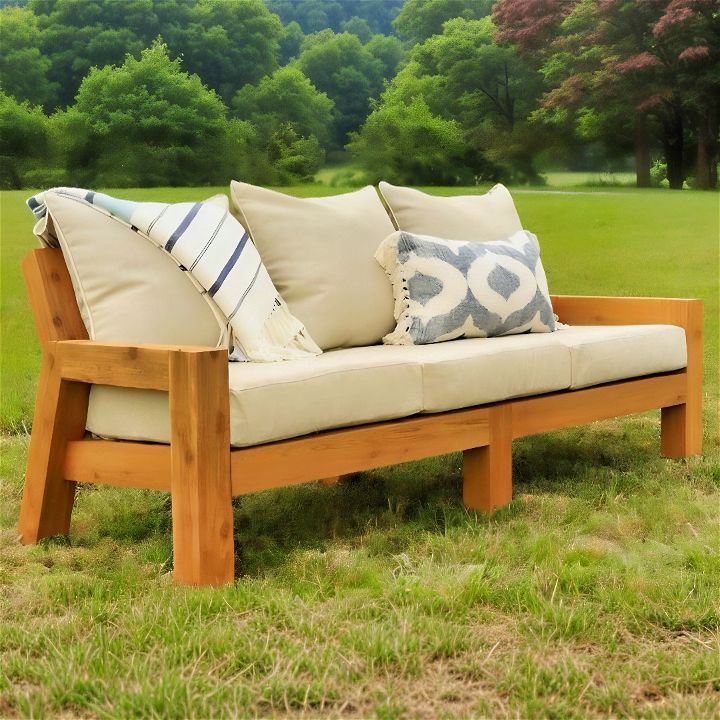
Your Guide’s Experience
Sarah from Woodshop Diaries brings this project to life with her hands-on experience. Determined to build an outdoor sofa that not just looks good but is also highly functional, she designs the sofa around pre-selected cushions. This approach ensures a perfect fit and avoids the hassle of sourcing cushions for a pre-built frame.
Her use of Cedar for both durability and aesthetics, coupled with a practical approach to woodworking, demonstrates a depth of expertise. The inclusion of building plans in her tutorial streamlines the process, allowing even beginners to achieve great results.
What Will You Achieve?
By following this guide, you will learn how to:
- Design and plan an outdoor sofa that perfectly fits your cushions.
- Choose the right materials for outdoor durability and appeal.
- Construct a sturdy frame using simple woodworking techniques.
- Apply finishing touches for a professional look and extended lifespan.
Prioritizing User Needs
Before beginning, ensure you have all necessary tools and materials. This project primarily requires Cedar 4x4s and 2x4s, pocket hole screws, timber screws, stain, and sealant, along with standard woodworking tools.
Frame Construction
- Start by building the side frames. Each side consists of a square front leg, an angled back leg, and a top connecting piece from 4x4s.
- Cut a 2×4 seat support with mitered ends to match the slope of the back leg and attach it between the front and back leg to support the seat slats.
Sanding and Prepping
- Sand all your pieces before assembly to avoid splinters and ensure a smooth finish.
Assembly
- Use pocket holes and screws to connect the frames’ components. Note: The screws should be outdoor-rated to resist weathering.
- Construct and attach the back framing, ensuring sturdiness with timber screws.
- Add a middle support for the seat slats to prevent sagging.
Adding Slats
- Begin with the back seat slat and the bottom back slat, attaching them to provide additional support for middle assembly.
- Install the remaining slats, spacing them evenly.
Finishing Touches
- Apply an outdoor stain and sealant to protect the wood. Consider staining the pieces before assembly to make the process easier.
Common Pitfalls & Troubleshooting
- Wood Choice: Cedar is preferred for its longevity outdoors, but ensure the wood is free from deep knots that may weaken your sofa.
- Assembly: Confirm all measurements and cuts before drilling or cutting. Precision here saves time later.
- Staining: If staining post-assembly, use a smaller brush or sponge to reach between slats for an even coat.
Why These Steps?
The systematic approach, starting from frame construction to finishing, ensures structural integrity and aesthetic appeal. The emphasis on planning around cushions streamlines the build process and guarantees a custom fit.
Video Tutorial
Want a visual demonstration? Watch a step-by-step video tutorial on YouTube:
It provides a clear and easy-to-understand visual walkthrough of the techniques, making it a great companion to this written guide.
Design Hacks for Comfort and Style
Building an outdoor sofa that’s both comfortable and stylish doesn’t have to be complicated. With a few design hacks, you can ensure your outdoor seating is the perfect spot for relaxation and entertainment. Let’s dive into how you can adjust backrest angles, seat depths, choose armrest styles, and customize dimensions for everyone’s comfort.
Explore Different Backrest Angles and Seat Depths
The angle and depth of your sofa can significantly impact comfort. A backrest angle between 100 to 110 degrees is ideal for relaxation, while a seat depth of 20-24 inches suits most adults. To adjust these aspects:
- Backrest Angle: If your sofa feels too upright, adding a slight recline can increase comfort. Use wedges between the seat and backrest to adjust the angle.
- Seat Depth: For deeper seats, consider adding extra cushions for back support. If the seat is too deep, thicker seat cushions can reduce the depth, making it easier to sit and stand up.
Armrest Styles and Their Impact
Armrests add both functionality and style to your outdoor sofa. Here are a few types to consider:
- Flat, Wide Armrests: Great for placing drinks or books, adding practicality and a modern look.
- Rolled or Curved Armrests: These add an elegant touch and are comfortable to lean against, ideal for traditional or luxurious outdoor spaces.
- Minimal or No Armrests: Perfect for a sleek, contemporary style, and can make the sofa appear lighter and less bulky.
Customizing Dimensions for Comfort
Everyone’s comfort is different, especially when it comes to height. To customize your sofa for taller or shorter individuals:
- For Taller People: Increase the backrest height and seat depth to ensure adequate support. A seat height of 18-20 inches can also enhance comfort.
- For Shorter People: Opt for a lower seat height, around 16-18 inches, and a shallower seat depth. Consider adjustable or removable cushions to cater to different needs.
By considering these design hacks, you can create an outdoor sofa that’s not just a statement piece but also a haven of comfort and style. Remember, the key is to balance aesthetics with functionality, ensuring your outdoor space is welcoming and comfortable for everyone.
Conclusion
By following this guide, not only will you enhance your woodworking skills, but you’ll also create a beautiful, functional piece that adds value to your outdoor living space. Whether for lounging on sunny days or enjoying evening gatherings, your new outdoor sofa will be the highlight of your patio or garden.
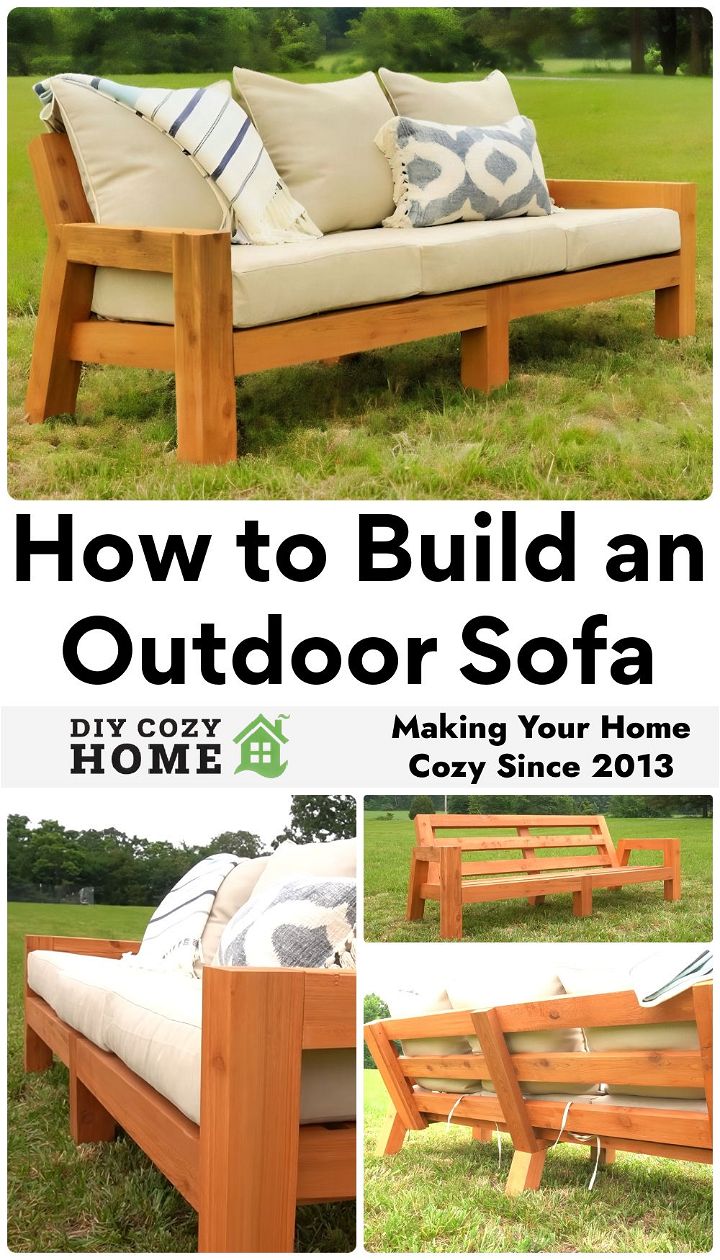
Build an Outdoor Sofa with Advanced Features and Weatherproofing
Making a durable outdoor sofa needs careful planning and material selection. Include features like storage, and choose the right upholstery to enhance your living space.
Built-in Storage Compartments
Maximize the utility of your outdoor sofa by designing built-in storage compartments under the seat. These can be perfect for stowing away cushions, gardening tools, or children’s toys. To create these, include a hinged seat or removable panels in your design. Ensure the storage space is weatherproof by sealing any gaps and considering drainage solutions to prevent water accumulation.
Incorporating Planter Boxes
Integrate planter boxes into the ends of your sofa to add a green touch and personalize your outdoor space. Ensure the planters have proper drainage and are lined to prevent moisture damage to the wood. Choose plants that complement your outdoor décor and can thrive in the available sunlight.
Add-ons for Enhanced Comfort and Functionality
Retractable Shade
A retractable shade can protect against harsh sunlight, allowing you to enjoy your outdoor space at any time of the day. Consider a canvas canopy that slides on wires or a foldable wooden frame that matches your sofa design. Ensure the mechanism is easy to operate and securely attached to withstand windy conditions.
Pull-out Side Tables
Side tables are perfect for holding drinks, books, or decorative items. Design pull-out tables that can be hidden when not in use to save space. Use durable materials and ensure smooth operation of the sliding mechanism.
Upholstery and Weatherproofing
Protect your furniture by following this upholstery and weatherproofing guide. Keep your pieces looking great and lasting longer.
Outdoor-grade Fabrics
Selecting the right fabric is crucial for the durability and appearance of your outdoor sofa. Look for outdoor-grade materials that offer fade resistance and water resistance. Acrylic fabrics are a popular choice due to their resistance to UV light and mildew. Ensure the fabric complements your outdoor décor while providing practical benefits.
Cushion Types
Comfort and durability are key when choosing cushions. Opt for high-resilience foam that provides support and retains its shape over time. Consider the thickness of the cushion based on your desired comfort level. For weather resistance, look for cushions with a waterproof cover or consider a water-resistant inner liner.
Finishes or Sealants
Protecting your outdoor sofa from the elements is essential. Choose a finish or sealant based on the material of your sofa. For wood, options include varnish, sealant, or an oil finish that enhances the natural beauty while providing UV and water resistance. Apply the finish according to the manufacturer’s instructions and consider reapplying periodically to maintain protection.
Cost-Saving Strategies for Building an Outdoor Sofa
Building an outdoor sofa can enhance your backyard or patio without draining your wallet. Here are some tips to help you save money while creating a cozy and stylish outdoor space.
Finding Deals on Lumber or Alternative Sourcing
- Check Local Listings: Websites like Craigslist or Facebook Marketplace often have people giving away lumber for free or selling it at a lower cost than retail stores.
- Visit Construction Sites: Some construction sites may have excess lumber they’re willing to give away or sell at a discount. Always ask for permission first.
- Reclaimed Wood: Look for reclaimed wood from old furniture, pallets, or barns. Not only is this eco-friendly, but it also adds character to your sofa.
- Lumber Yards: Sometimes, lumber yards offer discounts on pieces that are slightly imperfect. These imperfections won’t affect the structural integrity of your outdoor sofa.
Borrowing or Renting Tools
- Community Sharing: Check if your community has a tool-sharing program. This is an affordable way to use high-quality tools without purchasing them.
- Renting: Many hardware stores offer tool rentals. Renting is cost-effective, especially for tools you’ll use only once or twice.
- Friends and Family: Don’t forget about your network. Often, friends or family members are willing to lend you the tools you need.
Simplifying the Design
- Choose a Basic Shape: Opt for a simple rectangular design. This reduces the number of cuts and materials needed, making the project more manageable.
- Skip the Backrest: Building a sofa without a backrest or with a low backrest can save on materials and simplify construction.
- Pallet Foundation: Use pallets as the base for your sofa. They’re sturdy, readily available, and can save a lot of time and money.
- Minimalist Approach: Reduce the number of decorative elements. Focus on functionality. Simple can be both beautiful and cost-effective.
By applying these strategies, you can create a charming outdoor sofa that adds value to your home without overspending. Remember, the key is to plan, be resourceful, and embrace simplicity.

